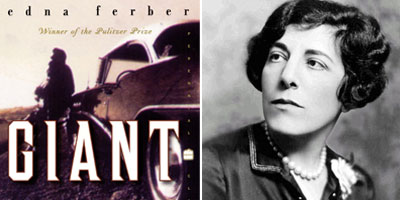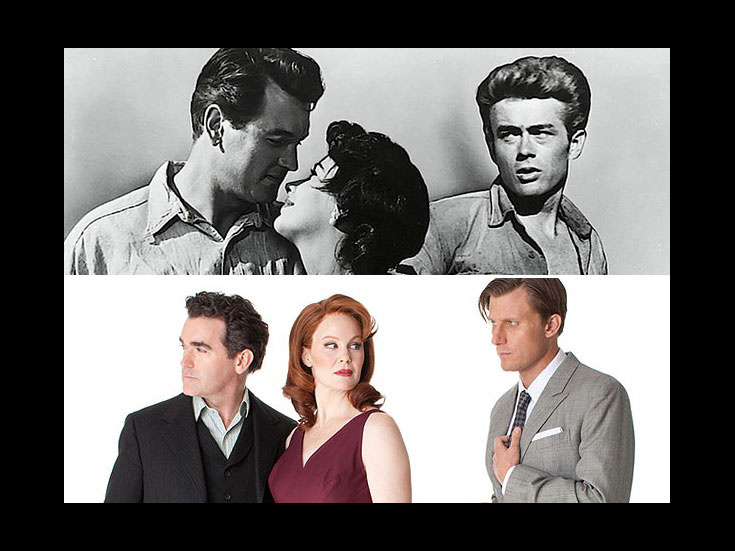How the Mega-Sized Off-Broadway Musical Giant Dives Deep Into the Heart of Texas
They say that everything is bigger in Texas…including the musicals! The Public Theater is presenting the NYC premiere of Giant, a musical based on the 1952 novel by Edna Ferber. We dug deep into the history of this Lone Star State saga (best known now for the starry 1956 film adaptation) and the epic musical it inspired.

A Novel of Epic Proportions
The mammoth Texas tale of Giant began life as little more than an idea in the head of Edna Ferber, one of the country's most successful storytellers between World Wars I and II. Ferber’s quintessentially American writing lent itself to adaptations in other mediums, including her 1926 book-turned-musical-turned-movie Show Boat and 1929 novel Cimarron, which was adapted into an Oscar-winning Best Picture in 1931. Ferber also collaborated with George S. Kaufman to pen the oft-revived Broadway plays Dinner at Eight and The Royal Family.
In 1952, near the end of her career, Ferber wrote Giant, an epic saga of a cattle-ranching family’s sprawling history in the Texas heartland. Set on a million-plus acreage of rich Texan land called Reata, the novel follows the multigenerational Benedict family, led by conventional patriarch Bick and his New England-born socialite wife Leslie, whose three-decades-long marriage frames a greater dialogue about the advent of big oil and Southwestern attitudes towards Mexicans in the early twentieth century.
As always, Ferber's ability to capture the country's mood via juicy fictional characters made Giant a hot Hollywood property. Within two years, pre-production began on a film adaptation by Warner Bros. The expectations for Giant meant that this big-budget movie needed to live up to its name.

Texas in Tinsel Town
With a colossal 201-minute runtime, the film adaptation of Giant was a challenging undertaking by director George Stevens. Three of the era’s most popular stars led the cast: Rock Hudson starred as the stoic Bick alongside Elizabeth Taylor (chosen by Hudson over Grace Kelly) as his glamorous wife, Leslie; James Dean signed on to play ranch hand-turned-oil tycoon Jett Rink in what would be the actor’s final role before a car accident claimed his life in September 1955.
Giant opened on October 10, 1956, to excellent response for both the acting (Hudson, Dean and Mercedes McCambridge as Bick's hostile sister Luz earned Oscar nominations) and the film's timely social messages. The cultural impact of Giant was immediately apparent, with reviews of the film praising its portrayal of the truths of racism. Particular attention was drawn to the parallels between the exploitation of Mexicans and the struggles of African-Americans in the Deep South.
The film was the highest-grossing picture in Warner Bros. history for more than 20 years, earning 10 Academy Award nominations and one win, for Best Director. The American Film Institute listed Giant as the 82nd best movie ever made, and in 2005 the United States National Film Registry selected the film for preservation—the highest honor an American film can achieve.

“Biggest Production Ever!”
Ferber’s novel is still in print and Warner Bros.’ plush movie is readily available on Netflix, but Giant found new life in 2009 in the form of a musical commissioned by Signature Theatre Company of Arlington, VA. Ferber’s great-niece Julie Gilbert was at work on a biography about her famous relative when she approached Tony-nominated composer-lyricist Michael John LaChiusa (The Wild Party) about adapting the novel for the musical stage. Daunted at first, LaChiusa eventually was persuaded and teamed up with Tony-nominated writer Sybille Pearson (Baby) to write the book for his country-infused score.
Structured into three acts, the world premiere of Giant bowed at Signature on April 28, 2009, clocking in at a whopping four hours. Leading the cast were Lewis Cleale as Bick, Betsy Morgan as Leslie, Ashley Robinson as Jett and John Dossett (who would reprise his role in future versions of the show) as Uncle Bawley. In spite of its length, the musical grabbed the attention of audiences, theater journalists—and New York’s Public Theater.
After the Public got involved, Giant went through two years of workshops before earning a second mounting in Dallas, TX. The show was shortened by an hour, three acts were shrunk to two, and LaChiusa replaced a number of songs in his panoramic score. For the Dallas mounting, Rent and Next to Normal director Michael Greif came onboard, joined by Aaron Lazar as Bick, Kate Baldwin as Leslie and P.J. Griffith as Jett. Billed as Dallas Theatre Center’s “biggest production ever,” the show ran for a month, closing on February 19, 2012. A transfer to New York was the logical next step.

Open to the Public
After a heavy helping of cuts and edits, Giant has landed at the newly renovated Public Theater. Baldwin and Griffith reprise their starring roles, with two-time Tony nominee Brian d’Arcy James donning the belt buckle of brawny Bick Benedict. According to Griffith, the show has changed not just structurally but thematically, as well, largely due to the difference in audience responses.
“What they laugh at and what they 'get' in Texas is totally different than in New York,” the young actor told Broadway.com a week before opening night. “A blue state versus a red state is a different play.” That said, the entire story has been streamlined since its last run, and changes continued through previews to strengthen show’s relevant messages. “After those first [presidential] debates, we did a bunch of rewrites,” revealed Griffith, adding that modern attitudes towards oil and the ‘drill, baby, drill’ mentality add a timely air. “I’ve yet to do two shows that are the same. It’s been a constantly evolving piece.”
Another unexpected twist came less than a week into previews: Giant, for its heft, was not immune to the wrath of Mother Nature, as the cast missed almost a week of rehearsals and performances after Hurricane Sandy. With power back up and running, Giant is back in action, with opening night set for November 15. Next stop, Broadway?
Giant opens on November 15 at the Public Theater and runs through December 2.
 Rock Hudson, Elizabeth Taylor & James Dean in the movie version;
Rock Hudson, Elizabeth Taylor & James Dean in the movie version;Brian d'Arcy James, Kate Baldwin & P.J. Griffith in the musical 'Giant'
